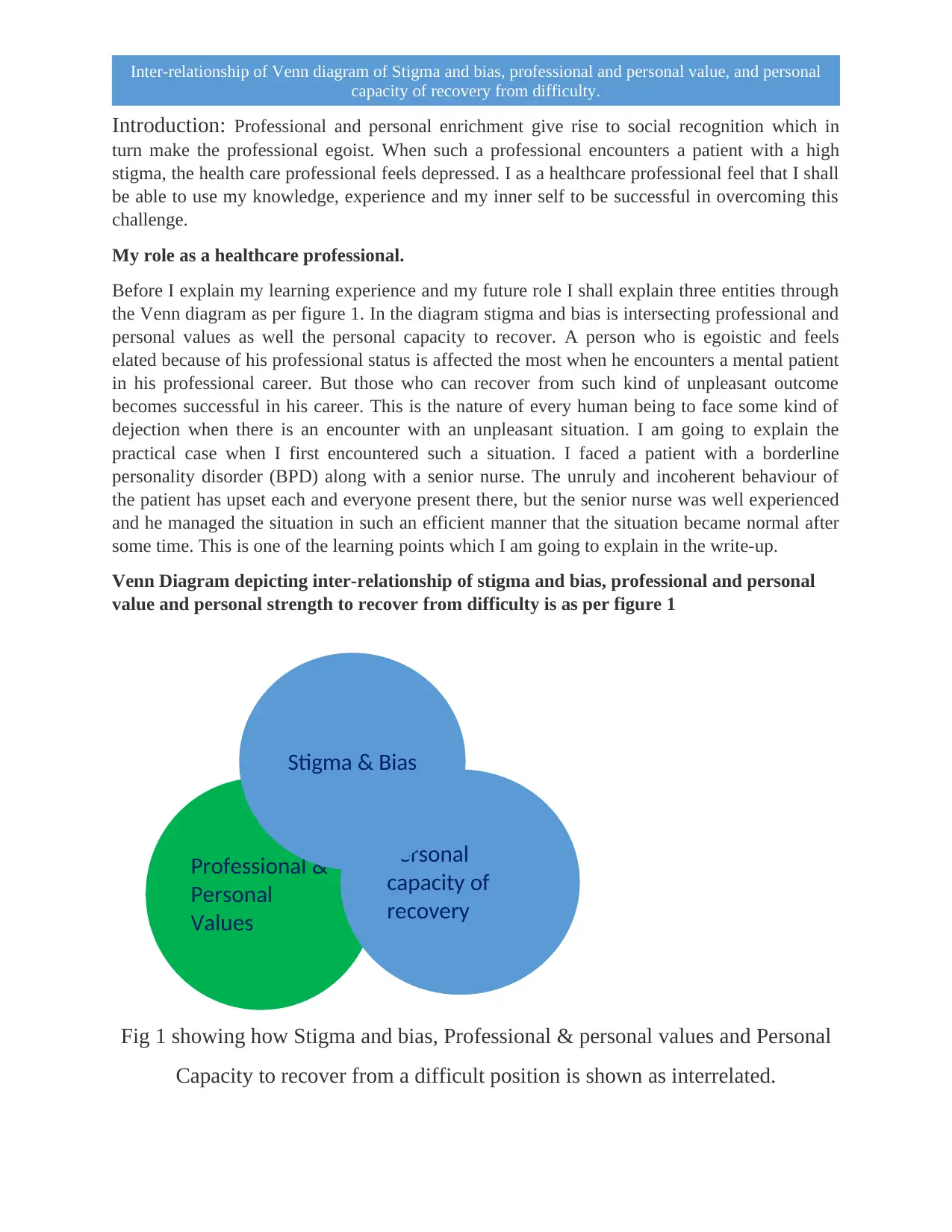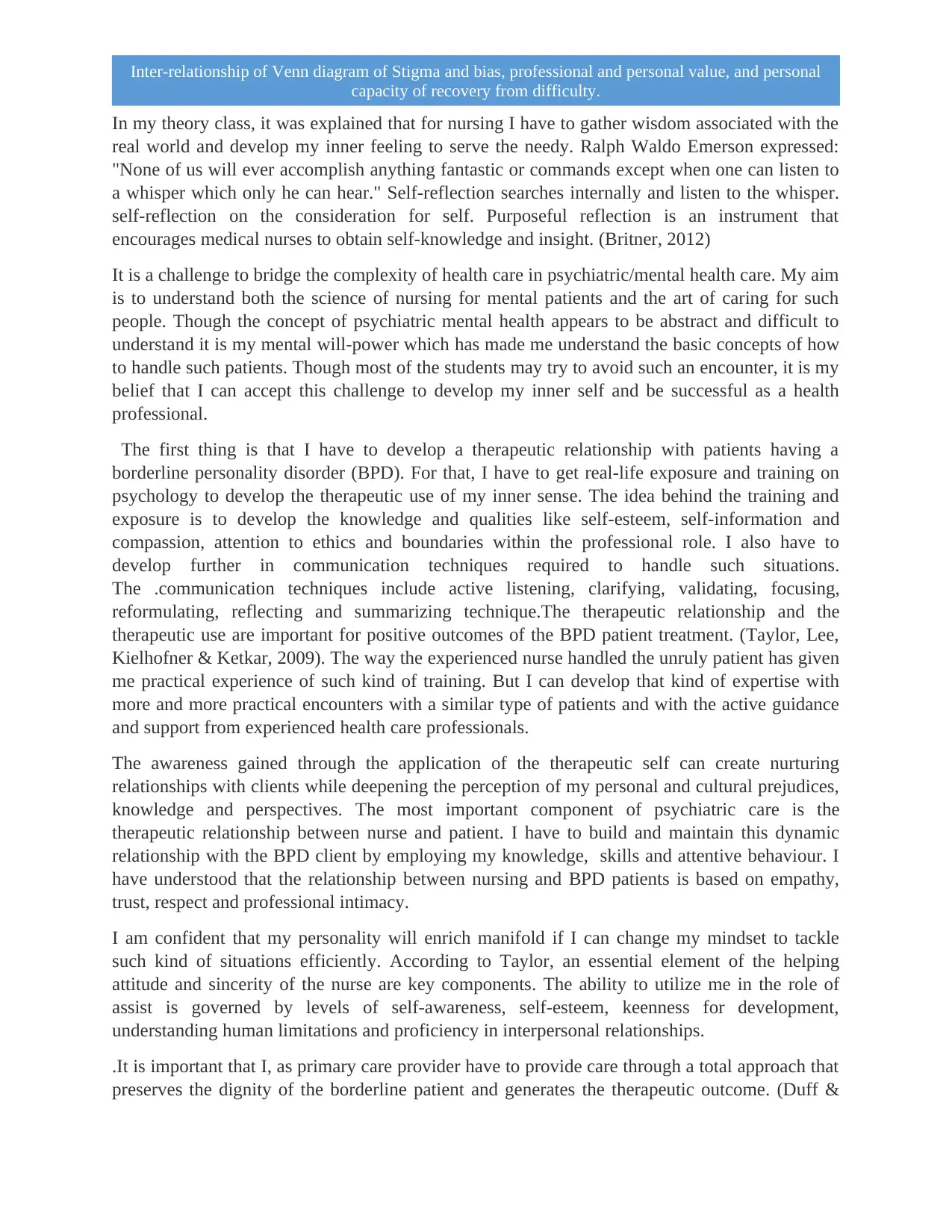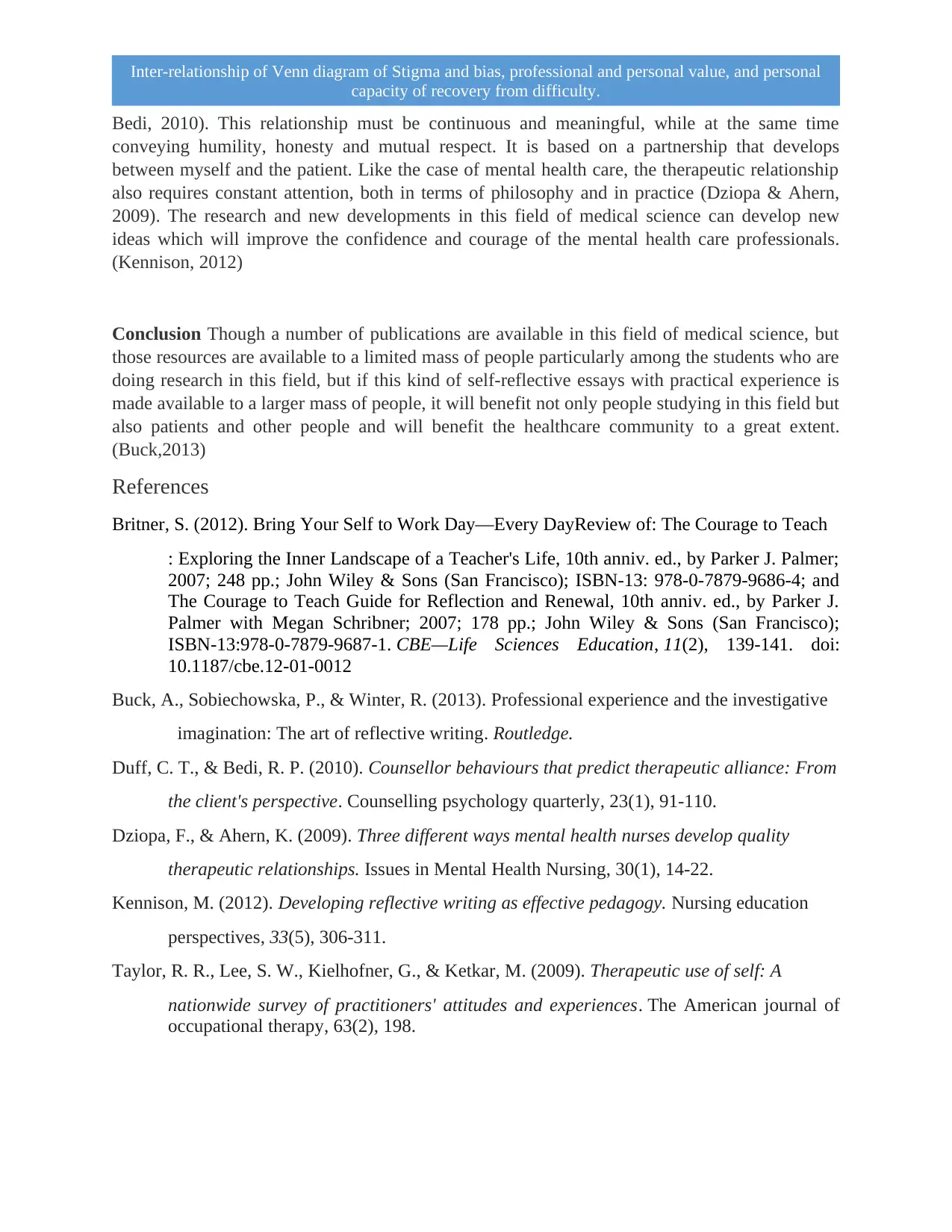101965 Reflective Essay: Interplay of Stigma, Values & Recovery
VerifiedAdded on 2023/04/23
|3
|1501
|58
Essay
AI Summary
This essay provides a reflective interpretation of the interrelationships between stigma and bias, professional and personal values, and the personal capacity for recovery from difficult circumstances, particularly in the context of therapeutic use of self in healthcare. The author uses a Venn diagram to illustrate these interconnections and shares a personal experience of encountering a patient with borderline personality disorder, highlighting the importance of developing therapeutic relationships, self-awareness, and communication skills. The essay emphasizes the need for healthcare professionals to address their own prejudices, cultivate empathy, and build trust with patients to achieve positive outcomes. It concludes by advocating for wider access to reflective essays and practical experiences to benefit both healthcare professionals and patients. Desklib offers a platform to explore similar essays and resources for students.

Introduction: Professional and personal enrichment give rise to social recognition which in
turn make the professional egoist. When such a professional encounters a patient with a high
stigma, the health care professional feels depressed. I as a healthcare professional feel that I shall
be able to use my knowledge, experience and my inner self to be successful in overcoming this
challenge.
My role as a healthcare professional.
Before I explain my learning experience and my future role I shall explain three entities through
the Venn diagram as per figure 1. In the diagram stigma and bias is intersecting professional and
personal values as well the personal capacity to recover. A person who is egoistic and feels
elated because of his professional status is affected the most when he encounters a mental patient
in his professional career. But those who can recover from such kind of unpleasant outcome
becomes successful in his career. This is the nature of every human being to face some kind of
dejection when there is an encounter with an unpleasant situation. I am going to explain the
practical case when I first encountered such a situation. I faced a patient with a borderline
personality disorder (BPD) along with a senior nurse. The unruly and incoherent behaviour of
the patient has upset each and everyone present there, but the senior nurse was well experienced
and he managed the situation in such an efficient manner that the situation became normal after
some time. This is one of the learning points which I am going to explain in the write-up.
Venn Diagram depicting inter-relationship of stigma and bias, professional and personal
value and personal strength to recover from difficulty is as per figure 1
Fig 1 showing how Stigma and bias, Professional & personal values and Personal
Capacity to recover from a difficult position is shown as interrelated.
Inter-relationship of Venn diagram of Stigma and bias, professional and personal value, and personal
capacity of recovery from difficulty.
Professional &
Personal
Values
Personal
capacity of
recovery
Stigma & Bias
turn make the professional egoist. When such a professional encounters a patient with a high
stigma, the health care professional feels depressed. I as a healthcare professional feel that I shall
be able to use my knowledge, experience and my inner self to be successful in overcoming this
challenge.
My role as a healthcare professional.
Before I explain my learning experience and my future role I shall explain three entities through
the Venn diagram as per figure 1. In the diagram stigma and bias is intersecting professional and
personal values as well the personal capacity to recover. A person who is egoistic and feels
elated because of his professional status is affected the most when he encounters a mental patient
in his professional career. But those who can recover from such kind of unpleasant outcome
becomes successful in his career. This is the nature of every human being to face some kind of
dejection when there is an encounter with an unpleasant situation. I am going to explain the
practical case when I first encountered such a situation. I faced a patient with a borderline
personality disorder (BPD) along with a senior nurse. The unruly and incoherent behaviour of
the patient has upset each and everyone present there, but the senior nurse was well experienced
and he managed the situation in such an efficient manner that the situation became normal after
some time. This is one of the learning points which I am going to explain in the write-up.
Venn Diagram depicting inter-relationship of stigma and bias, professional and personal
value and personal strength to recover from difficulty is as per figure 1
Fig 1 showing how Stigma and bias, Professional & personal values and Personal
Capacity to recover from a difficult position is shown as interrelated.
Inter-relationship of Venn diagram of Stigma and bias, professional and personal value, and personal
capacity of recovery from difficulty.
Professional &
Personal
Values
Personal
capacity of
recovery
Stigma & Bias
Paraphrase This Document
Need a fresh take? Get an instant paraphrase of this document with our AI Paraphraser

In my theory class, it was explained that for nursing I have to gather wisdom associated with the
real world and develop my inner feeling to serve the needy. Ralph Waldo Emerson expressed:
"None of us will ever accomplish anything fantastic or commands except when one can listen to
a whisper which only he can hear." Self-reflection searches internally and listen to the whisper.
self-reflection on the consideration for self. Purposeful reflection is an instrument that
encourages medical nurses to obtain self-knowledge and insight. (Britner, 2012)
It is a challenge to bridge the complexity of health care in psychiatric/mental health care. My aim
is to understand both the science of nursing for mental patients and the art of caring for such
people. Though the concept of psychiatric mental health appears to be abstract and difficult to
understand it is my mental will-power which has made me understand the basic concepts of how
to handle such patients. Though most of the students may try to avoid such an encounter, it is my
belief that I can accept this challenge to develop my inner self and be successful as a health
professional.
The first thing is that I have to develop a therapeutic relationship with patients having a
borderline personality disorder (BPD). For that, I have to get real-life exposure and training on
psychology to develop the therapeutic use of my inner sense. The idea behind the training and
exposure is to develop the knowledge and qualities like self-esteem, self-information and
compassion, attention to ethics and boundaries within the professional role. I also have to
develop further in communication techniques required to handle such situations.
The .communication techniques include active listening, clarifying, validating, focusing,
reformulating, reflecting and summarizing technique.The therapeutic relationship and the
therapeutic use are important for positive outcomes of the BPD patient treatment. (Taylor, Lee,
Kielhofner & Ketkar, 2009). The way the experienced nurse handled the unruly patient has given
me practical experience of such kind of training. But I can develop that kind of expertise with
more and more practical encounters with a similar type of patients and with the active guidance
and support from experienced health care professionals.
The awareness gained through the application of the therapeutic self can create nurturing
relationships with clients while deepening the perception of my personal and cultural prejudices,
knowledge and perspectives. The most important component of psychiatric care is the
therapeutic relationship between nurse and patient. I have to build and maintain this dynamic
relationship with the BPD client by employing my knowledge, skills and attentive behaviour. I
have understood that the relationship between nursing and BPD patients is based on empathy,
trust, respect and professional intimacy.
I am confident that my personality will enrich manifold if I can change my mindset to tackle
such kind of situations efficiently. According to Taylor, an essential element of the helping
attitude and sincerity of the nurse are key components. The ability to utilize me in the role of
assist is governed by levels of self-awareness, self-esteem, keenness for development,
understanding human limitations and proficiency in interpersonal relationships.
.It is important that I, as primary care provider have to provide care through a total approach that
preserves the dignity of the borderline patient and generates the therapeutic outcome. (Duff &
Inter-relationship of Venn diagram of Stigma and bias, professional and personal value, and personal
capacity of recovery from difficulty.
real world and develop my inner feeling to serve the needy. Ralph Waldo Emerson expressed:
"None of us will ever accomplish anything fantastic or commands except when one can listen to
a whisper which only he can hear." Self-reflection searches internally and listen to the whisper.
self-reflection on the consideration for self. Purposeful reflection is an instrument that
encourages medical nurses to obtain self-knowledge and insight. (Britner, 2012)
It is a challenge to bridge the complexity of health care in psychiatric/mental health care. My aim
is to understand both the science of nursing for mental patients and the art of caring for such
people. Though the concept of psychiatric mental health appears to be abstract and difficult to
understand it is my mental will-power which has made me understand the basic concepts of how
to handle such patients. Though most of the students may try to avoid such an encounter, it is my
belief that I can accept this challenge to develop my inner self and be successful as a health
professional.
The first thing is that I have to develop a therapeutic relationship with patients having a
borderline personality disorder (BPD). For that, I have to get real-life exposure and training on
psychology to develop the therapeutic use of my inner sense. The idea behind the training and
exposure is to develop the knowledge and qualities like self-esteem, self-information and
compassion, attention to ethics and boundaries within the professional role. I also have to
develop further in communication techniques required to handle such situations.
The .communication techniques include active listening, clarifying, validating, focusing,
reformulating, reflecting and summarizing technique.The therapeutic relationship and the
therapeutic use are important for positive outcomes of the BPD patient treatment. (Taylor, Lee,
Kielhofner & Ketkar, 2009). The way the experienced nurse handled the unruly patient has given
me practical experience of such kind of training. But I can develop that kind of expertise with
more and more practical encounters with a similar type of patients and with the active guidance
and support from experienced health care professionals.
The awareness gained through the application of the therapeutic self can create nurturing
relationships with clients while deepening the perception of my personal and cultural prejudices,
knowledge and perspectives. The most important component of psychiatric care is the
therapeutic relationship between nurse and patient. I have to build and maintain this dynamic
relationship with the BPD client by employing my knowledge, skills and attentive behaviour. I
have understood that the relationship between nursing and BPD patients is based on empathy,
trust, respect and professional intimacy.
I am confident that my personality will enrich manifold if I can change my mindset to tackle
such kind of situations efficiently. According to Taylor, an essential element of the helping
attitude and sincerity of the nurse are key components. The ability to utilize me in the role of
assist is governed by levels of self-awareness, self-esteem, keenness for development,
understanding human limitations and proficiency in interpersonal relationships.
.It is important that I, as primary care provider have to provide care through a total approach that
preserves the dignity of the borderline patient and generates the therapeutic outcome. (Duff &
Inter-relationship of Venn diagram of Stigma and bias, professional and personal value, and personal
capacity of recovery from difficulty.

Bedi, 2010). This relationship must be continuous and meaningful, while at the same time
conveying humility, honesty and mutual respect. It is based on a partnership that develops
between myself and the patient. Like the case of mental health care, the therapeutic relationship
also requires constant attention, both in terms of philosophy and in practice (Dziopa & Ahern,
2009). The research and new developments in this field of medical science can develop new
ideas which will improve the confidence and courage of the mental health care professionals.
(Kennison, 2012)
Conclusion Though a number of publications are available in this field of medical science, but
those resources are available to a limited mass of people particularly among the students who are
doing research in this field, but if this kind of self-reflective essays with practical experience is
made available to a larger mass of people, it will benefit not only people studying in this field but
also patients and other people and will benefit the healthcare community to a great extent.
(Buck,2013)
References
Britner, S. (2012). Bring Your Self to Work Day—Every DayReview of: The Courage to Teach
: Exploring the Inner Landscape of a Teacher's Life, 10th anniv. ed., by Parker J. Palmer;
2007; 248 pp.; John Wiley & Sons (San Francisco); ISBN-13: 978-0-7879-9686-4; and
The Courage to Teach Guide for Reflection and Renewal, 10th anniv. ed., by Parker J.
Palmer with Megan Schribner; 2007; 178 pp.; John Wiley & Sons (San Francisco);
ISBN-13:978-0-7879-9687-1. CBE—Life Sciences Education, 11(2), 139-141. doi:
10.1187/cbe.12-01-0012
Buck, A., Sobiechowska, P., & Winter, R. (2013). Professional experience and the investigative
imagination: The art of reflective writing. Routledge.
Duff, C. T., & Bedi, R. P. (2010). Counsellor behaviours that predict therapeutic alliance: From
the client's perspective. Counselling psychology quarterly, 23(1), 91-110.
Dziopa, F., & Ahern, K. (2009). Three different ways mental health nurses develop quality
therapeutic relationships. Issues in Mental Health Nursing, 30(1), 14-22.
Kennison, M. (2012). Developing reflective writing as effective pedagogy. Nursing education
perspectives, 33(5), 306-311.
Taylor, R. R., Lee, S. W., Kielhofner, G., & Ketkar, M. (2009). Therapeutic use of self: A
nationwide survey of practitioners' attitudes and experiences. The American journal of
occupational therapy, 63(2), 198.
Inter-relationship of Venn diagram of Stigma and bias, professional and personal value, and personal
capacity of recovery from difficulty.
conveying humility, honesty and mutual respect. It is based on a partnership that develops
between myself and the patient. Like the case of mental health care, the therapeutic relationship
also requires constant attention, both in terms of philosophy and in practice (Dziopa & Ahern,
2009). The research and new developments in this field of medical science can develop new
ideas which will improve the confidence and courage of the mental health care professionals.
(Kennison, 2012)
Conclusion Though a number of publications are available in this field of medical science, but
those resources are available to a limited mass of people particularly among the students who are
doing research in this field, but if this kind of self-reflective essays with practical experience is
made available to a larger mass of people, it will benefit not only people studying in this field but
also patients and other people and will benefit the healthcare community to a great extent.
(Buck,2013)
References
Britner, S. (2012). Bring Your Self to Work Day—Every DayReview of: The Courage to Teach
: Exploring the Inner Landscape of a Teacher's Life, 10th anniv. ed., by Parker J. Palmer;
2007; 248 pp.; John Wiley & Sons (San Francisco); ISBN-13: 978-0-7879-9686-4; and
The Courage to Teach Guide for Reflection and Renewal, 10th anniv. ed., by Parker J.
Palmer with Megan Schribner; 2007; 178 pp.; John Wiley & Sons (San Francisco);
ISBN-13:978-0-7879-9687-1. CBE—Life Sciences Education, 11(2), 139-141. doi:
10.1187/cbe.12-01-0012
Buck, A., Sobiechowska, P., & Winter, R. (2013). Professional experience and the investigative
imagination: The art of reflective writing. Routledge.
Duff, C. T., & Bedi, R. P. (2010). Counsellor behaviours that predict therapeutic alliance: From
the client's perspective. Counselling psychology quarterly, 23(1), 91-110.
Dziopa, F., & Ahern, K. (2009). Three different ways mental health nurses develop quality
therapeutic relationships. Issues in Mental Health Nursing, 30(1), 14-22.
Kennison, M. (2012). Developing reflective writing as effective pedagogy. Nursing education
perspectives, 33(5), 306-311.
Taylor, R. R., Lee, S. W., Kielhofner, G., & Ketkar, M. (2009). Therapeutic use of self: A
nationwide survey of practitioners' attitudes and experiences. The American journal of
occupational therapy, 63(2), 198.
Inter-relationship of Venn diagram of Stigma and bias, professional and personal value, and personal
capacity of recovery from difficulty.
⊘ This is a preview!⊘
Do you want full access?
Subscribe today to unlock all pages.

Trusted by 1+ million students worldwide
1 out of 3
Related Documents
Your All-in-One AI-Powered Toolkit for Academic Success.
+13062052269
info@desklib.com
Available 24*7 on WhatsApp / Email
![[object Object]](/_next/static/media/star-bottom.7253800d.svg)
Unlock your academic potential
Copyright © 2020–2025 A2Z Services. All Rights Reserved. Developed and managed by ZUCOL.





